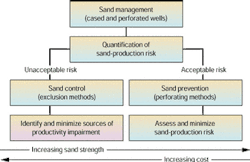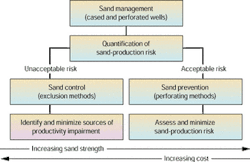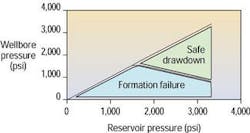PERFORATING TECHNOLOGY: Well perforating solutions redefine sand management strategies
Strategies for managing sand production have evolved from applying mainly mechanical sand control methods to including sophisticated perforating techniques that prevent or eliminate produced sand during the life of a well.
Historically, whenever the risk of sand production existed, the approach to managing it typically relied on conventional sand control exclusion methods. However, the methods that controlled sand in wells often were found to impair their productivity as well. Solving productivity problems began with identifying and then minimizing the impairment source.
The problems then led the industry to seek alternative solutions for managing sand production such as sand prevention techniques that use perforating methods as opposed to exclusion methods for controlling sand.
Managing sand production
Sand management involves first quantifying sand production risk to determine if, how, and when sand-control or sand-prevention techniques should be applied. Sand control uses methods to exclude sand from produced fluids. Gravel packing is the traditional method, but new innovations include screenless completions, fracturing and packing (often with tip screenouts), resin consolidations, proppant flowback control, and optimized hydraulic fracturing.
Sand prevention applies techniques to minimize or delay sand production, and does so by optimizing perforating practices rather than applying mechanical methods. When sand production risk is acceptably low, prevention techniques would likely be pursued. Conversely, when this risk is unacceptably high, sand control methods often are the preferred course.
The tendency for a well to produce sand along with oil, water, and gas depends on numerous factors such as formation strength, perforation stresses, flow rate, and fluid type. Formations that are too weak to support a perforation tunnel are unlikely candidates for sand prevention techniques.
Sand production in more competent formations arises from either tunnel collapse or loose sand in the tunnel. The main factors causing transient production of loose sand in the perforation tunnel are:
- Changing flow rates related to pressure drawdown
- Changing water cut because of water production increasing with time.
For a well to produce a more substantial amount of sand with fluids, studies have shown that perforation tunnels must first fail. Then, flow rates must be sufficient for the fluid to carry the failed sand. Therefore, effective formation stress, controlled by drawdown and depletion, provides the failure mechanism. The flow rate, also controlled by drawdown, provides the transport means.
Consequently, perforation tunnel stability determines whether sand production will be a concern in a completed well. In addition to single-perforation instability, the interlinking of failed zones around adjacent perforations, dictated by the distances between perforations, can lead to formation structural collapse and induced sand production. Perforation and formation stability and the ability to accurately predict them influence whether sand-control or sand-prevention strategies should be undertaken.
Perforating tunnel stability
Several methods are available to predict perforation tunnel stability. The most widely used sand predictions are based on historical prod-uction experiences of existing wells in the same reservoirs. In certain instances, reservoir strength data can be used to identify an analogous, or similar, field whose producing history can help predict the potential for sand production in a well targeted for completion. A particularly effective use of this forecasting meth-od takes the historical data available to calibrate theoretical models used to predict future sand production.
Other methods for predicting tunnel stability include theoretical models, which are extensions of models developed originally for borehole stability. The three-step theoretical modeling process involves determining rock mechanical properties using log data and core samples, evaluating in-situ stress environments and estimating perforation failure conditions. Two theoretical models focus on different failure mechanisms:
- Tensile stress from fluid flow into the perforation cavity
- Shear stress according to an assumed material behavior.
Tensile failure models tend to be used less frequently, with the most widely used shear failure model being Mohr-Coulomb for predicting shear stress conditions and failure mechanisms. Experimental methods test either outcrop rock or core samples that have mechanical properties similar to the reservoir targeted for completion. There are two different laboratory-testing methods: drilled-hole tests and single-shot perforation and flow tests.
Preventing sand production
Provided the risk of producing sand is acceptably low during a well's productive life, sand prevention-perforating techniques often can be utilized rather than sand control methods. To prevent sand production, perforation designs should maximize perforated hole spacing, as well as minimize hole size in the formation, pressure drawdown across perforated intervals, and flow rate per perforation.
Optimizing perforating practices involves optimizing the parameters related to perforating operations. These include charge type, shot density, phase angle, and in special cases, orientation:
- Charge type: Small-diameter perforations created by deep penetrating charges are recommended for sand prevention. Smaller perforation tunnel diameters are more stable than larger ones created by big-hole charges. While small, deep perforation tunnels enhance single-perforation stability during drawdown and depletion, they also, along with optimum perforation spacing, enhance the stability of the adjacent formation.
- Shot density: When zones around perforation tunnels fail and interlink, the collapsing formation can cause massive sand production. The distances between perforations dictate the stability of this adjacent formation. Smaller holes and lower shot densities serve to increase perforation spacing and formation stability. However, this also has the undesirable effect of increasing a perforation's flow rate and facilitating the transport of failed formation material that can promote sand production. Higher shot densities keep pressure drawdown, flow rate, and drag forces through each perforation below a critical value. The objective is to minimize the pressure drop across the surfaces of the perforation tunnels.
- Phase angle: In addition to shot density, phasing also dictates perforation spacing. Optimizing the phase angle for a given wellbore radius and shot density maximizes the perforation-to-perforation spacing, which in turn decreases or avoids entirely interaction between adjacent perforations and the surrounding rock. This reduces formation failure and zonal interlinking risk without compromising individual perforation flow rates. For example, custom-designed perforating systems developed by Schlumberger can be used to optimize phasing for maximum between-perforation distances and minimal collapsed formation risk.
Optimal phasing effectiveness in preventing sand production was demonstrated in the BP Amoco Magnus field in the North Sea. Originally, the perforating strategy utilized guns at 60-degree phasing and six shots per foot (spf). The strategy was optimized to 99-degree phased perforations, while maintaining the same shot density and charge type. Wells perforated at optimum phasing produced less sand and experienced fewer sand-related problems.
Increased perforation spacing for an optimum versus standard gun phasing scheme can be significant. For the Magnus field, by changing a centralized gun to 99 degrees from 60-degree phasing, minimum perforation spacing increased 56%, to 7.61 in. from 4.88 in.
A 2-D plane strain model of the two different perforating strategies simulated tunnel failure resulting from increasing effective stress. Similar interlinking effects of failed zones adjacent to the 99-degree phased perforation tunnels required 1.3 times the effective stress increases from drawdown and depletion, compared to the 60 degree phasing.
- Perforation orientation: In anisotropic stress environments, oriented perforating techniques can be used to maximize perforation stability. With in-situ stress distribution knowledge and large formation stress contrasts, oriented perforating can increase tunnel stability by targeting the most stable direction. For a vertical well, perforating guns are oriented in the same directions as the preferred fracture plane.
When high shot densities are required to maximize productivity, gun phasing can be adjusted to orient perforations by a small variant to either side of the minimum stress contrast direction, for maximum perforation-to-perforation spacing and minimal sand production throughout the well life. Typically +/- 25 degrees or less, the specific size of the acceptable phasing deviation from the plane can be determined using models and failure analysis techniques.
PDVSA has applied these sand prevention techniques to four wells at its Eocene C reservoir in Lake Maracaibo, Venezuela. They were perforated, oriented in the direction of minimum stress contrast with phasing custom designed to shoot within +/- 25 degrees of the minimum stress contrast plane. The sand prevention objective was achieved successfully in all four cases.
Perforating horizontal wells presents a special case of oriented perforating. In vertical wells, the perforation tunnels can be made in any direction radially to the wellbore, but essentially horizontal in the formation. In horizontal wells, the perforation tunnels can be made in any direction radially to the wellbore and in the formation.
Perforating at under-balance enables loose perforation sand to be produced early on, which helps avoid sand management and production issues during the later stages of a well's life. Under-balance perforating also reduces perforation damage in the crushed zone - the damaged zone around the perforation tunnel walls. However, caution must be exercised because too much under-balance can cause catastrophic tunnel failure.
Perforation stability models determine under-balance values and generate a safe operating envelope, so that limits can be maintained below critical pressure drawdown levels for formation failure. Single-shot perforation and flow tests on cores can confirm these under-balance values, further safeguarding against perforation and formation failure while perforating.
Controlling sand production
When substantial risk for sand production exists, mechanical methods such as gravel packing are often necessary to exclude sand from produced fluids. Therefore, alternative perforating measures must be taken to minimize induced perforation damage and potential gravel-pack impairment.
In conventional gravel pack operations, the main perforating objective is to minimize pressure drop across the gravel-filled perforations and in casing and cement tunnels. The gravel permeability, per-perforation flow rate, and total area open to flow (AOF) influence this pressure drop. Big-hole charges and high shot densities maximize the AOF - the area of individual holes multiplied by the total number of shots - which in turn, minimizes the pressure drop across perforations.
Under-balanced perforating is particularly applicable prior to gravel-pack sand control operations for minimizing perforation damage, and formation fines. Core sample tests have shown that debris and fines in perforation tunnels can impair gravel permeability. Perforating designs should have sufficiently high under-balance to clean up damage, fines, and debris, yet be below levels that could cause perforation collapse and catastrophic sand production.
When such perforating objectives are set, the operator may find that the required AOF exceeds the capabilities of the perforating systems available. One operator determined that its program would require a minimum AOF of 15 sq in./ft. This greatly exceeded the capabilities of available gun systems at the time.
To meet this specific requirement, a Schlumberger HSD perforating system was developed, incorporating PowerFlow 7018 charges in a 7-in. gun carrier at 18 spf. The result was an 18.5-sq in./ft AOF in 9 5/8-in. casing. The operator's perforating objectives were met, maximizing AOF and optimizing well productivity while controlling sanding.
Determining whether the created tunnels and the formation surrounding them will be stable over the well's producing life is an important step when evaluating sand management options. Tunnel collapse or formation failure between perforations causes sand production in unconsolidated and some weak, consolidated formations. Problems associated with sand production can adversely affect reservoir productivity and project profitability.
Moreover, if not addressed early on, sand problems can compound to the extent that the produced sand jeopardizes future well intervention options.
Enhanced risk assessment and increasingly sophisticated perforating techniques have addressed these problems, and will continue to do so by offering strategies for selecting the most appropriate technology-based solutions to manage and eliminate sand over a well's productive life.
References
Venkitaraman, A.; Behrmann, L.; and Noordermeer, A.: "Perforating Requirements for Sand Prevention," SPE 58788, SPE International Symposium on Formation Damage Control, Lafayette, LA, Feb., 2000.
Behrmann, L.; Brooks, J.E.; Farrant, S.; Fayard, A.; Venkitaraman, A.; Brown, A.; Michel, C.; Noordermeer, A.; Smith, P.; and Underdown, D.: "Perforating Practices That Optimize Productivity," Oilfield Review 12, no. 1, Spring 2000.
Sulbaran, A.; Carbonell, R.; and Lopez-de-Cardenas, J.: "Oriented Perforating for Sand Prevention," SPE 57954, SPE European Formation Damage Conference, The Hague, The Netherlands, May-June, 1999.
Acknowledgments
Schlumberger granted permission to publish this article.
Authors
Robert A. Parrott is a Senior Engineer in the Perforating Gun Systems Department, Schlumberger Reservoir Completions Center, Rosharon, Texas. He has 5 years experience in wireline operations and 19 years in R&D, developing high shot density gun systems. He has a BSME from the University of Manitoba and an MBA from Houston Baptist University.
Ian C. Walton is a Scientific Advisor and Manager of the Productivity Enhancement Research Facility, Perforating Research Department, Schlumberger Reservoir Completions Center, Rosharon, Texas. He has 29 years of R&D experience at the university level and in the oil and gas industry. He holds a BS from University College, London, and a Ph.D. from Manchester University, both in mathematics.




